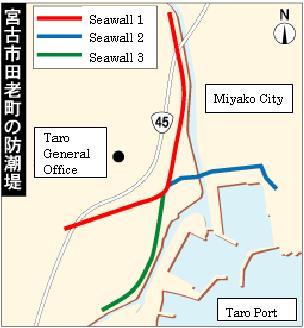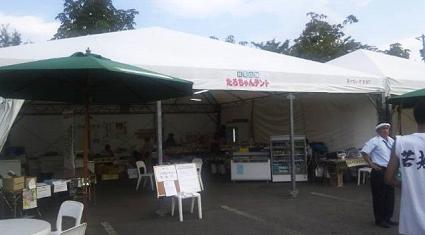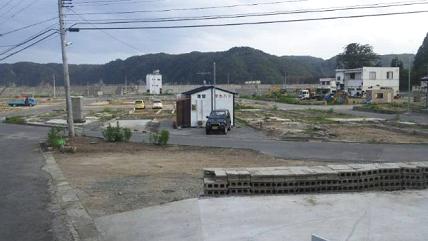Reported by Masaaki Minami, Iwate University
Taro district (approx. 4500 residents and 1600 households before the earthquake) in Miyako City, Iwate, is located on the Sanriku Coast. This district, which had suffered damages from tsunamis many times in the past, was known for its most advanced structural countermeasures against tsunami. Huge tsunami seawalls 10 meters above sea level in height were laid out throughout the district in an X-shape as secondary levees. The central part of the district, however, was devastated by the March 11, 2011 Great Eastern Japan Earthquake and Tsunami Disaster. As a result, 166 people were killed, and nearly 1100 buildings were damaged, of which 851 were washed away.

Tsunami seawalls in Taro district
Shortly after the disaster, the survivors took shelter in nine evacuation areas. A month later, they were assembled into one evacuation center, which was set up in the indoor sports facility of Greenpia Sanriku Miyako, a resort hotel situated north of the central area about five minutes away by car. This evacuation center has since been closed and the evacuees have all moved into the 400 or so temporary housing units constructed within the site of the hotel.
Here in a town full of disaster victims, small business owners who had lost their shops in the tsunami got together and started a project to set up their own market. They had their first meeting as early as April 6 and after that they got together once a week.
It was on May 15 that the owners were able to finally open a temporary market called “Taro-chan Tent”, using two 10m2 tents that the prefectural government lent them for free. Though the opening was behind schedule, those involved said the delay turned out to be better because the first group of the evacuees moved into the temporary housing units on the same day.
Unlike a life at an evacuation shelter, life at the temporary housing demands evacuees to be independent to some extent. As for meals, evacuees were provided with food rations and served cooked meals in an evacuation shelter, but at the temporary housing they were required to buy ingredients and cook their own food. The evacuees also did not tend to come out of their homes once they moved into the temporary housing. Therefore there was a need for the residents to meet and communicate with one another. The opening of Taro-chan Tent could not have been timed better.
Taro-chan Tent was later spread to the outdoor swimming pool and to the club house, which were located within a few minutes’ walk from the first tent. Currently 26 business owners are involved in the management. They have established a system for the evacuees to obtain daily necessities; food, sweets, rice, fruit and vegetable, dairy products, household commodities, beverages, alcohol, cigarettes, shoes, clocks, photos, electric appliances, garages, barbers services, etc.
Mr. Takahashi, who runs a barber shop there, is a certified disaster prevention specialist. He has long been greatly interested in designing a community to minimize tsunami damage. He has a great enthusiasm for Taro’s recovery. As his barber shop located in the central part of town was washed away, he opened a temporary shop in the clubhouse near the temporary housing. Very recently, he has opened another shop in the downtown area which was mostly swept away. This is because he was determined that he would be the first to come back to central Taro.
Mr. Tanaka, a confectionary shop owner, is a branch leader of the citizens’ fire and disaster management team. He had sold karinto, Taro’s specialty, at his shop along the national highway, but the shop was washed away. Though he was a victim himself, he had been one of the local leaders involved in various relief activities from the very beginning, closing the gates of the tsunami seawalls, providing emergency rescue, and searching for bodies.
On July 30, 2011, the owners of Taro-chan Tent held a kickoff meeting for the establishment of the ‘Taro-chan Cooperative’. The co-op administers another jointly owned store which is under construction at the parking lot in which Taro-chan Tent is located. The construction is currently in the process of foundation work, and is supposed to be completed by mid-September, falling a little behind schedule. They are discussing the practical use of the building whose structure will be durable enough to last 10-20 years. They also plan to start a mobile grocery-shop service to the areas that were not flooded by the tsunami, seeking to revitalize commerce in the whole Taro district.
Mr. Hakoishi, a food retailer and one of the initiators of Taro-chan Tent, says he wants to keep the Taro-chan Tent even after the new store building opens. He said he’d like to keep utilizing the advantages of the tent structure which creates an open atmosphere, attracts a lot of people, and makes it easy for even elderly women using wheeled walkers to come in.
Community-building efforts in the temporary housing site continue today for the recovery of Taro.

Taro-chan Tent temporary market (Aug. 10)

Mr. Takahashi’s temporary barber shop in what used to be downtown Taro (Aug. 10)